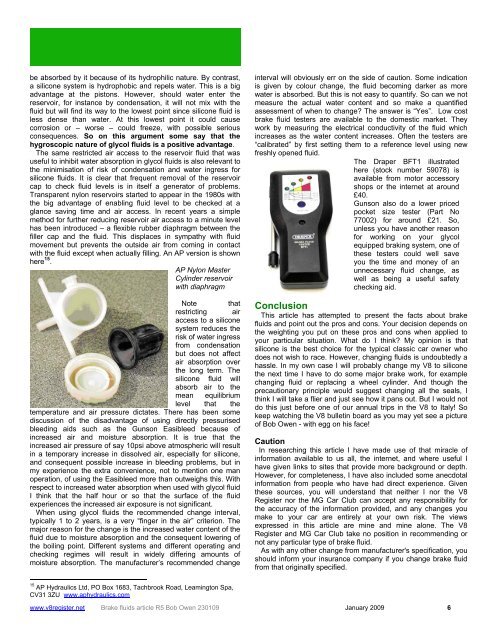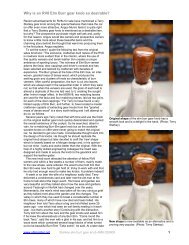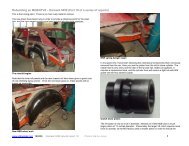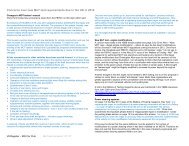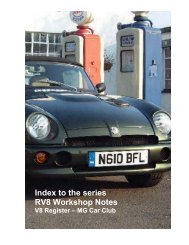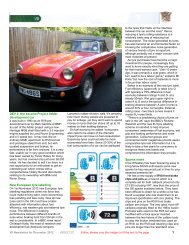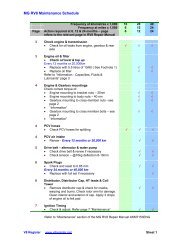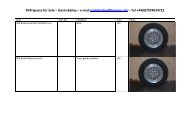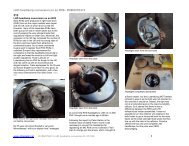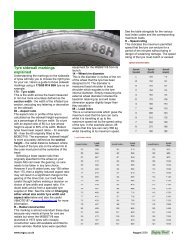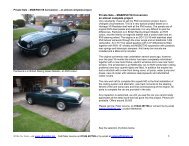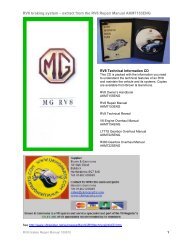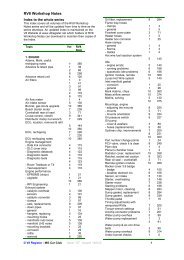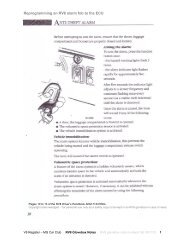Which brake fluid? What do DOT3, DOT4 and DOT 5 ... - V8 Register
Which brake fluid? What do DOT3, DOT4 and DOT 5 ... - V8 Register
Which brake fluid? What do DOT3, DOT4 and DOT 5 ... - V8 Register
You also want an ePaper? Increase the reach of your titles
YUMPU automatically turns print PDFs into web optimized ePapers that Google loves.
e absorbed by it because of its hydrophilic nature. By contrast,<br />
a silicone system is hydrophobic <strong>and</strong> repels water. This is a big<br />
advantage at the pistons. However, should water enter the<br />
reservoir, for instance by condensation, it will not mix with the<br />
<strong>fluid</strong> but will find its way to the lowest point since silicone <strong>fluid</strong> is<br />
less dense than water. At this lowest point it could cause<br />
corrosion or – worse – could freeze, with possible serious<br />
consequences. So on this argument some say that the<br />
hygroscopic nature of glycol <strong>fluid</strong>s is a positive advantage.<br />
The same restricted air access to the reservoir <strong>fluid</strong> that was<br />
useful to inhibit water absorption in glycol <strong>fluid</strong>s is also relevant to<br />
the minimisation of risk of condensation <strong>and</strong> water ingress for<br />
silicone <strong>fluid</strong>s. It is clear that frequent removal of the reservoir<br />
cap to check <strong>fluid</strong> levels is in itself a generator of problems.<br />
Transparent nylon reservoirs started to appear in the 1980s with<br />
the big advantage of enabling <strong>fluid</strong> level to be checked at a<br />
glance saving time <strong>and</strong> air access. In recent years a simple<br />
method for further reducing reservoir air access to a minute level<br />
has been introduced – a flexible rubber diaphragm between the<br />
filler cap <strong>and</strong> the <strong>fluid</strong>. This displaces in sympathy with <strong>fluid</strong><br />
movement but prevents the outside air from coming in contact<br />
with the <strong>fluid</strong> except when actually filling. An AP version is shown<br />
here 15 .<br />
AP Nylon Master<br />
Cylinder reservoir<br />
with diaphragm<br />
Note that<br />
restricting air<br />
access to a silicone<br />
system reduces the<br />
risk of water ingress<br />
from condensation<br />
but <strong>do</strong>es not affect<br />
air absorption over<br />
the long term. The<br />
silicone <strong>fluid</strong> will<br />
absorb air to the<br />
mean equilibrium<br />
level that the<br />
temperature <strong>and</strong> air pressure dictates. There has been some<br />
discussion of the disadvantage of using directly pressurised<br />
bleeding aids such as the Gunson Easibleed because of<br />
increased air <strong>and</strong> moisture absorption. It is true that the<br />
increased air pressure of say 10psi above atmospheric will result<br />
in a temporary increase in dissolved air, especially for silicone,<br />
<strong>and</strong> consequent possible increase in bleeding problems, but in<br />
my experience the extra convenience, not to mention one man<br />
operation, of using the Easibleed more than outweighs this. With<br />
respect to increased water absorption when used with glycol <strong>fluid</strong><br />
I think that the half hour or so that the surface of the <strong>fluid</strong><br />
experiences the increased air exposure is not significant.<br />
When using glycol <strong>fluid</strong>s the recommended change interval,<br />
typically 1 to 2 years, is a very “finger in the air” criterion. The<br />
major reason for the change is the increased water content of the<br />
<strong>fluid</strong> due to moisture absorption <strong>and</strong> the consequent lowering of<br />
the boiling point. Different systems <strong>and</strong> different operating <strong>and</strong><br />
checking regimes will result in widely differing amounts of<br />
moisture absorption. The manufacturer’s recommended change<br />
15 AP Hydraulics Ltd, PO Box 1683, Tachbrook Road, Leamington Spa,<br />
CV31 3ZU www.aphydraulics.com<br />
interval will obviously err on the side of caution. Some indication<br />
is given by colour change, the <strong>fluid</strong> becoming darker as more<br />
water is absorbed. But this is not easy to quantify. So can we not<br />
measure the actual water content <strong>and</strong> so make a quantified<br />
assessment of when to change? The answer is “Yes”. Low cost<br />
<strong>brake</strong> <strong>fluid</strong> testers are available to the <strong>do</strong>mestic market. They<br />
work by measuring the electrical conductivity of the <strong>fluid</strong> which<br />
increases as the water content increases. Often the testers are<br />
“calibrated” by first setting them to a reference level using new<br />
freshly opened <strong>fluid</strong>.<br />
The Draper BFT1 illustrated<br />
here (stock number 59078) is<br />
available from motor accessory<br />
shops or the internet at around<br />
£40.<br />
Gunson also <strong>do</strong> a lower priced<br />
pocket size tester (Part No<br />
77002) for around £21. So,<br />
unless you have another reason<br />
for working on your glycol<br />
equipped braking system, one of<br />
these testers could well save<br />
you the time <strong>and</strong> money of an<br />
unnecessary <strong>fluid</strong> change, as<br />
well as being a useful safety<br />
checking aid.<br />
Conclusion<br />
This article has attempted to present the facts about <strong>brake</strong><br />
<strong>fluid</strong>s <strong>and</strong> point out the pros <strong>and</strong> cons. Your decision depends on<br />
the weighting you put on these pros <strong>and</strong> cons when applied to<br />
your particular situation. <strong>What</strong> <strong>do</strong> I think? My opinion is that<br />
silicone is the best choice for the typical classic car owner who<br />
<strong>do</strong>es not wish to race. However, changing <strong>fluid</strong>s is un<strong>do</strong>ubtedly a<br />
hassle. In my own case I will probably change my <strong>V8</strong> to silicone<br />
the next time I have to <strong>do</strong> some major <strong>brake</strong> work, for example<br />
changing <strong>fluid</strong> or replacing a wheel cylinder. And though the<br />
precautionary principle would suggest changing all the seals, I<br />
think I will take a flier <strong>and</strong> just see how it pans out. But I would not<br />
<strong>do</strong> this just before one of our annual trips in the <strong>V8</strong> to Italy! So<br />
keep watching the <strong>V8</strong> bulletin board as you may yet see a picture<br />
of Bob Owen - with egg on his face!<br />
Caution<br />
In researching this article I have made use of that miracle of<br />
information available to us all, the internet, <strong>and</strong> where useful I<br />
have given links to sites that provide more background or depth.<br />
However, for completeness, I have also included some anec<strong>do</strong>tal<br />
information from people who have had direct experience. Given<br />
these sources, you will underst<strong>and</strong> that neither I nor the <strong>V8</strong><br />
<strong>Register</strong> nor the MG Car Club can accept any responsibility for<br />
the accuracy of the information provided, <strong>and</strong> any changes you<br />
make to your car are entirely at your own risk. The views<br />
expressed in this article are mine <strong>and</strong> mine alone. The <strong>V8</strong><br />
<strong>Register</strong> <strong>and</strong> MG Car Club take no position in recommending or<br />
not any particular type of <strong>brake</strong> <strong>fluid</strong>.<br />
As with any other change from manufacturer's specification, you<br />
should inform your insurance company if you change <strong>brake</strong> <strong>fluid</strong><br />
from that originally specified.<br />
www.v8register.net Brake <strong>fluid</strong>s article R5 Bob Owen 230109 January 2009 6


